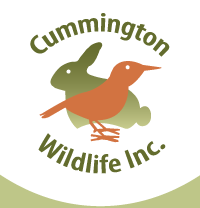
Please be aware that Cummington Wildlife, Inc. is not liable for injuries to person or property during the capture or transport of an animal to our facility. Do not attempt to capture or transport an animal unless you have the knowledge and means to do it safely.
Emergency (temporary) care of wildlife involves providing some assistance until the animal is able to be placed with a veterinarian or wildlife rehabilitator. The placement of the animal should occur within eight hours maximum of finding the distressed animal. Remember that most animals are in critical condition when captured by humans and every minute counts if the animal is to be saved.
The first step is to capture the animal without injury to you, the public, or the animal. Remember that a wild animal will view you as a predator and not a friend trying to help it. The animal will try to defend itself with teeth, claws, and talons. Use good judgment and try to look at the situation from the animal's perspective. Don't attempt to capture an animal unless you feel confident about doing it safely. Here are a few useful hints for capturing a wild animal, but remember that each case is distinctly different.
- Wear thick, leather gloves for protection against teeth, claws, etc. The use of gloves is also helpful for preventing transmission of diseases from the animal to you and vice versa. Gloves also help to prevent transferring the human scent to orphaned wildlife, which can be important for many species. Always wash your hands after handling wildlife.
- Have a container prepared before you approach the animal. Please note that the size of the container is very important. The container should be large enough for the animal to turn around with some extra room. However, an excessively large container can cause an animal to thrash around and become injured. The container must have a cover, ventilation holes, and a soft cloth on the bottom for the comfort of the animal. Avoid cloth with loops, such as terry cloth, because the animal can get their claws caught in the material. Make sure the container is sturdy enough to secure the animal. A cardboard box will secure a robin, but an adult squirrel can chew out of cardboard in seconds!
- Watch out for safety hazards for yourself and the animal. Don't risk your own safety chasing the animal into the street unless you know that traffic has been stopped in both directions!
- Try to corner the animal and encourage it to run into your container without being touched by you. A broom can be gently used to persuade an animal to enter the container.
- Sometimes a net or blanket can be thrown over an animal so it can be scooped up and placed into the container.
- Do not destroy property (i.e. an animal is caught in a vent or fence) without authorization from the property owner. You might end up paying for the repair bill.
Once the animal is captured, it is important to place the animal in a quiet and warm place. Animals can die from stress and need time to rest from the capture experience. Place half the container on a heating pad on low. The animal can move from the warm spot to the cooler spot at will. (Note: For infant birds, please refer to the bird care section.) Do not handle the animal after capture. Keep pets and children away from the container to minimize stress and prevent spread of infectious disease. Remember that some diseases, such as rabies, can be fatal to humans so use caution. Do not give the animal anything to eat or drink unless advised by a wildlife rehabilitator or a veterinarian.
